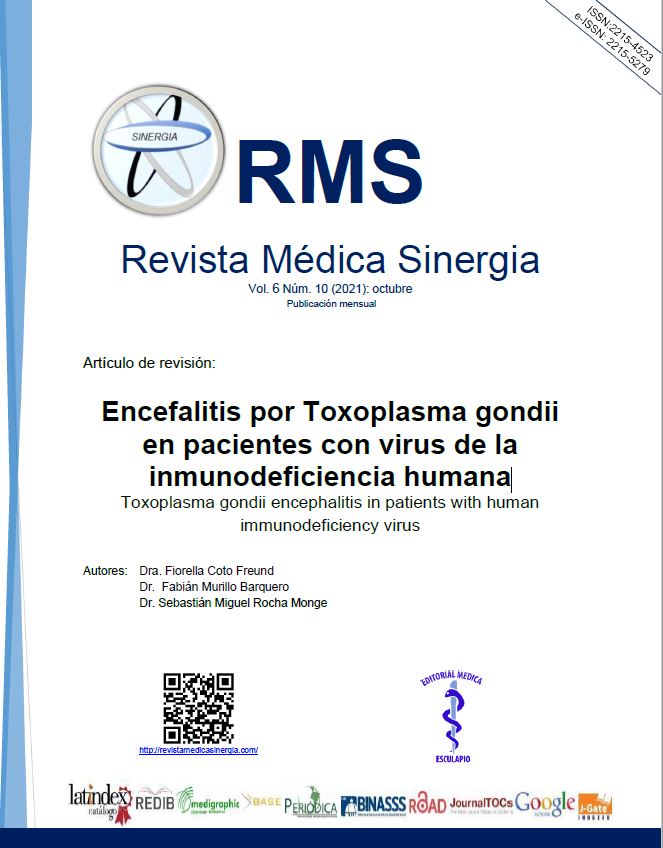Abstract
Seropositive patients with CD4 counts less than 100 cells/microL who do not have adequate antiretroviral treatment have up to a 30% probability of being infected with Toxoplasma gondii, an opportunistic parasite that can cause ophthalmic, neurological, and rarely systemic complications. Central nervous system involvement should be suspected in the context of human immunodeficiency virus positive, immunocompromised patients with neurological symptoms suggesting central level involvement; for which, imaging studies will be the first choice to obtain a rapid and timely diagnosis, which allows an adequate therapeutic regimen to be started as soon as possible.
Keywords
References
Marra CM. Central nervous system infection with Toxoplasma gondii. Handb Clin Neurol. 2018;152:117–22.
Elsheikha HM, Marra CM, Zhu X-Q. Epidemiology, pathophysiology, diagnosis, and management of cerebral toxoplasmosis. Clin Microbiol Rev [Internet]. 2021;34(1). Disponible en: http://dx.doi.org/10.1128/CMR.00115-19
UpToDate [Internet]. Uptodate.com. [citado el 7 de julio de 2021]. Disponible en: https://www.uptodate.com/contents/toxoplasmosis-in-patients-with-hiv/print?search=toxoplasma
Wang Z-D, Wang S-C, Liu H-H, Ma H-Y, Li Z-Y, Wei F, et al. Prevalence and burden of Toxoplasma gondii infection in HIV-infected people: a systematic review and meta-analysis. Lancet HIV. 2017;4(4):e177–88.
UpToDate [Internet]. Uptodate.com. [citado el 7 de julio de 2021]. Disponible en: https://www.uptodate.com/contents/toxoplasmosis-acute-systemic-disease/print?search=toxoplasma&source=search_result&selectedTitle=1~150&u%E2%80%A6
Vidal JE. HIV-related cerebral toxoplasmosis revisited: Current concepts and controversies of an old disease. J Int Assoc Provid AIDS Care. 2019;18:2325958219867315.
Schlüter D, Barragan A. Advances and challenges in understanding cerebral toxoplasmosis. Front Immunol. 2019;10:242.
Panel on Opportunistic Infections in HIV-Infected Adults and Adolescents. Guidelines for the prevention and treatment of opportunistic infections in HIV-infected adults and adolescents: Recommendations from the Centers for Disease Control and Prevention, the National Institutes of Health, and the HIV Medicine Association of the Infectious Diseases Society of America. http://aidsinfo.nih.gov/contentfiles/lvguideline s/adult_oi.pdf (Accessed on June 20, 2021).
Elicer I. Approach to an intracranial mass in patients with HIV. Curr Neurol Neurosci Rep. 2020;20(9):43.
Roche AD, Rowley D, Brett FM, Looby S. Concentric and eccentric target MRI signs in a case of HIV-associated cerebral toxoplasmosis. Case Rep Neurol Med. 2018;2018:1–3.
Greenway MRF, Sacco KA, Burton MC. In deep: Cerebral toxoplasmosis. Am J Med. 2017;130(7):802–4.
Bowen LN, Smith B, Reich D, Quezado M, Nath A. HIV-associated opportunistic CNS infections: pathophysiology, diagnosis and treatment. Nat Rev Neurol. 2016;12(11):662–74.
UpToDate [Internet]. Uptodate.com. [citado el 7 de julio de 2021]. Disponible en: https://www.uptodate.com/contents/overview-of-prevention-of-opportunistic-infections-in-patients-with-hiv
UpToDate [Internet]. Uptodate.com. [citado el 7 de julio de 2021]. Disponible en: https://www.uptodate.com/contents/approach-to-the-patient-with-hiv-and-central-nervous-system-lesions
Hernandez AV, Thota P, Pellegrino D, Pasupuleti V, Benites-Zapata VA, Deshpande A, et al. A systematic review and meta-analysis of the relative efficacy and safety of treatment regimens for HIV-associated cerebral toxoplasmosis: is trimethoprim-sulfamethoxazole a real option? HIV Med. 2017;18(2):115–24.

This work is licensed under a Creative Commons Attribution-NonCommercial 4.0 International License.
Copyright (c) 2021 Array


